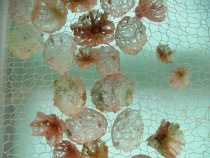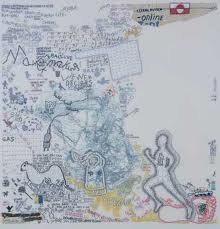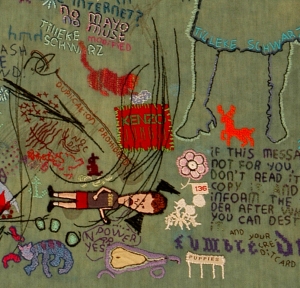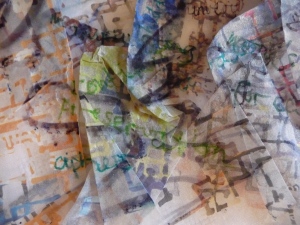I am aware that ideas are processing in the back of my mind most of the time, even when I’m not working. The cogs were turning after writing yesterday’s post and I remembered some work I did some time ago that seems to link with my recent samples; the first in terms of the materials used and the second with regard to content.



 This was a layered hanging, with a sheer, hand-embroidered back layer and a stiffened, knitted network with moulded, cup-like forms suspended on it. The use of heat to shape the synthetic fabric, the process of distressing with a soldering iron, the layering and the network could inform work around the idea of multilayered dialogue and meaning. Perhaps I could also play with the idea of transparency, complexity and opacity in communication.
This was a layered hanging, with a sheer, hand-embroidered back layer and a stiffened, knitted network with moulded, cup-like forms suspended on it. The use of heat to shape the synthetic fabric, the process of distressing with a soldering iron, the layering and the network could inform work around the idea of multilayered dialogue and meaning. Perhaps I could also play with the idea of transparency, complexity and opacity in communication.
The second set of samples had been worked around the idea of graffiti. The work was inspired by a visit to Prague where I took many photographs of the colourful wall layered in graffiti as a tribute to John Lennon. The original portrait of him was layered over with contributions from many different people. Visitors of various nationalities had added their names, dates, comments about the artist, political messages, or images. After the initial attraction and excitement of the bright colours, it was interesting to look more closely at the layers of writing and try to decipher the contributions of the many people who had added to the graffiti. Although the composition was completely random it was interesting to work from the photographs and isolate sections of it to reproduce in textiles.

This sample was constructed from handmade paper, layered and peeled back, painted, machine embroidered, hand embroidered and finished with acrylic wax.

Hand-dyed cotton with insertion stitch, hand and machine embroidery.

Painted calico and machine-embroidered scrim, printed, embossed and hand-pieced.
A selection of the original photos:-









On a visit to Grayson Perry’s recent exhibition “The Tomb of the Unknown Craftsman” at the British Museum. The exhibits I was most drawn to were the superb pots showing figures and comments on everyday life.
 They were highly crafted, but, in the manner of graffiti, some had layers of overlapping images and text, so that there was always something new to discover. The blue vase is entitled “Boring People”, and the yellow and blue The Rosetta Vase”. Figures are depicted alongside text captions, sometimes framed and at other times appearing in speech bubbles. This reminds me of artist Tilleke Schwartz, whose work I admire and which also includes contemporary personal and social commentary and has a similar energy to the work of Grayson Perry but in a different media -.art textiles. (Examples below)
They were highly crafted, but, in the manner of graffiti, some had layers of overlapping images and text, so that there was always something new to discover. The blue vase is entitled “Boring People”, and the yellow and blue The Rosetta Vase”. Figures are depicted alongside text captions, sometimes framed and at other times appearing in speech bubbles. This reminds me of artist Tilleke Schwartz, whose work I admire and which also includes contemporary personal and social commentary and has a similar energy to the work of Grayson Perry but in a different media -.art textiles. (Examples below)




Could it be that I have found my thread? Having come back around to elements that interested me a long time ago, I can see that perhaps choices I’ve made haven’t been as arbitrary as they seemed. Could the cogs be turning to find links and threads that reveal the connections I need to find a way to express my own significant ideas in a textile work that is also meaningful for others?
Graffiti is often a chance mixture of contributions from a range of people – jotting down or recording something that seems important to them at a certain time and place. Graffiti is layered – you often have to look carefully to decipher it and sometimes it is impossible to read. It can be meaningful or meaningless. It can be a declaration or a decoration or tribute. All of this applies to the ‘John Lennon wall’ in Prague,although it is not coherent as a work of art. Perhaps I could use this form to express my own thoughts and feelings about significant events or people in my life, without baring my soul. Whilst the artists work shown here features surface design, I might be able to combine this with a textured element to further disguise the content. Although each of us has our unique, personal experience of life, there is often a common element which strikes a chord. Glimpses of my own experience may resonate with offers when applied to their own experiences.
Perhaps I have found my thread!
Perhaps the form of my work needs to function as a metaphor for what Marsha Wineman calls “the space between communication and understanding”, and within that framework I can have my own space to use personal text or to make it universal.



 The colours should become more vibrant when heat set, but the sample already looks more powerful. I still don’t like the quality of printing inks on fabric, but the varied quality of the marks, scale and direction gives it more energy.
The colours should become more vibrant when heat set, but the sample already looks more powerful. I still don’t like the quality of printing inks on fabric, but the varied quality of the marks, scale and direction gives it more energy.



 Worth trying this with dye paints, starting with a print with the same screen, then painting and layering with the same tools in a similar colour range.
Worth trying this with dye paints, starting with a print with the same screen, then painting and layering with the same tools in a similar colour range.





































![6969[1]](https://dil58ligaffblog.files.wordpress.com/2011/12/69691.jpg?w=245&h=245)
![sptak[1]](https://dil58ligaffblog.files.wordpress.com/2011/12/sptak1.jpg?w=584)
![IDT1998_3Sot_i11[1]](https://dil58ligaffblog.files.wordpress.com/2011/12/idt1998_3sot_i111.jpg?w=300&h=200)
![057ptak[1]](https://dil58ligaffblog.files.wordpress.com/2011/12/057ptak1.jpg?w=235&h=300)


